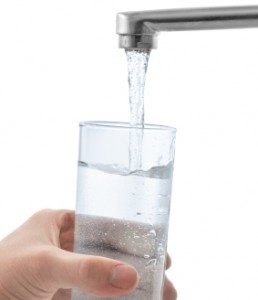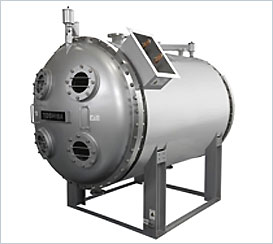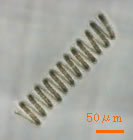Kugako Sugimoto, NOST Tokyo
Origineel gepubliceerd op de site van Agentschap NL
Samenvatting
Water uit de kraan in Japan is veilig en smaakt goed. Het drinkwater is zacht en bevat weinig mineralen. Het water van rivieren en ondergrondse bronnen dat als drinkwater wordt gebruikt, verblijft daar maar kort en neemt daardoor weinig mineralen op. Dit water wordt behandeld met chloor om het desinfecteren. Tegenwoordig wordt het water steeds vaker behandeld met ozon en/of UV-licht om micro-organismen die resistent zijn tegen de behandeling met chloor te verwijderen en voor verbetering geur van het drinkwater. De ongewenste bijproducten van deze behandeling, zoals trihalomethanen en bromaten zijn ondertussen door onderzoek verminderd. Ozonbehandeling wordt gevolgd met speciale monitoringsystemen en ozon wordt gegenereerd met behulp van efficiënte generatoren. Recente zorgen over de verontreiniging van drinkwater met radiaonucliden afkomsten van de kernramp in Fukushima zijn onderzocht en vrijwijl nihil bevonden.
Summary
Japanese tap water is believed to be safe and drinkable. Drinking water is soft containing few minerals due to short retention time of water in water sources. Chlorine is added to the water for disinfection. Ozone and UV treatment are gradually introduced as measures against chlorine resistant microorganisms and for better quality smell. Unwanted byproducts such as trihalomethane and bromate by the reaction of chlorine and UV light/ozone have been tackled. Monitoring systems for ozone treatment and effective ozone generators have been developed. Recent concerns of contamination of tap water by radioactive materials due to the Fukushima nuclear power plant disaster triggered extensive measurement to assure the water contains no radionuclides.
Details
Japanese tap water
The water resources of Japanese tap water roughly consist of 70% of surface water and 30% of ground water (Fig.1). Two thirds of ground water is from shallow wells and one third is from deep wells. The retention time of ground water is relatively short. The same goes for rivers due to Japan’s mountainous topography resulting in soft water with small amount of minerals. Monthly average temperature of tap water ranges from 7 in January to 28 in August. Yearly average of pH is 7.5 (6.9-7.9).
Fig. 1 Tap water
Unlike the no-chlorine-added tap water in the Netherlands, Waterworks Law in Japan enacted in 1957 regulates the minimum concentration of residual chlorine in water at the faucet with more than 0.1 mg/L to a combined residual chlorine limit of 0.4 mg/L for disinfection. Strong oxidation by chlorine destroys cell membranes, cell walls, proteins, nucleic acids of microorganisms and viruses. Each Waterworks Bureau of municipalities tries to keep the concentration less than 1 mg/L for several reasons such as taste and odor.
In addition, chlorine reacts with organics in the water and forms trihalomethane. Among trihalomethanes, chloroform and bromodichloromethane are suspected as carcinogens. Ministry of Health, Labour and Welfare set 0.1 mg/L as the maximum concentration of total trihalomethane.
Cryptosporidium
Despite input of chlorine to tap water, mass infection of Cryptosporidium parvum1 occurred in Saitama Prefecture in the north of Tokyo in 1996. C. parvum and some other indicator bacteria such as Giardia lamblia2 have tolerance to chlorine by forming a thick capsule around them. Oocysts3 of Cryptosporidium sp. were observed in raw water for a water supply facility and a hydrant in Saitama prefecture. 8,812 people were infected. It is known that the worst case caused by C. parvum is death. Currently, there are no guidelines on concetration in place because there is no concrete methodology for detecting infectious C. parvum and G. lamblia. The Plan for Water Quality Standard recommends the periodical checkups of Cryptosporidium sp. and Giardia sp. in the untreated water. Methods for checking are capturing, aggregation, and isolation of Cryptosporidium sp. and Giardia sp. Detection rate of C. parvum and G. lamblia is 47% and the detection limit is 2-440 oocysts / 10 L.
The indirect monitoring of infection with Cryptosporidium sp. is available and this monitors anaerobic spore-forming bacteria. Anaerobic spore-forming bacteria showed good correlation with Cryptosporidium sp. in the tested places in Japan. It is hoped that monitoring the increase of anaerobic spore-forming bacteria raises awareness about the infections by microorganisms for users of tap water.
UV treatment
Ministry of Health and Labour has made a guideline and monitoring methods for UV treatment against infection by C. parvum and G. lamblia in March of 2007. UV treatment on C. parvum and G. lamblia deprives infection ability of these microorganisms by damaging their DNA though inactivated C. parvum and G. lamblia still exist in the water.
Before the installation of UV treatment in the water supply systems for better water quality control, water types of water supply facilities in Japan were categorized into 4 levels, depending on suitability for UV treatment. For example, level 2 indicates that water facilities have not reported the infection of indicator species. Level 3 indicates that the facility reported infection of indicator species. Level 4 indicates the high possibility of infection of indicator species. UV treatment is applicable for level 3. However, level 4 requires an additional treatment to UV treatment, such as filtration by a filter basin. Level 4 water needs the addition of flocculants and to entrap Cryptosporidium sp. and Giardia sp. inside or at the surface of aggregates. Aggregates, then, sink to the bottom of a settling basin. Finally, filter basins remove aggregates containing of Cryptosporidium sp. and Giardia sp. By the end of March of 2013, investigations on Cryptosporidium sp. and Giardia sp. were conducted for 87%, 17554 out of 20124, of water supply facilities of Japan. 42% of investigated facilities of levels 3 and 84% of those of level 4 employed the measures against infection by Cryptosporidium sp. and Giardia sp. Such measures start with the serious monitoring of turbidity. This makes possible to confirm log reduction4 of log 3 (99.9%) to log 4 (99.99%). In addition, UV treatment (9mJ/cm2, integral UV dose) or ozone treatment is required after this monitoring. The log reductions of Cryptosporidium sp. and Giardia sp. by following filtration are log 5-7 for both water of level 3 and level 4.
Photoreactivation from UV treatment
Photoreactivation or dark reactivation is a phenomenon of the resurrection of dead microorganisms once exposed to UV light. This process involves the repair of damaged DNA by using the dead microorganisms own enzymes. C. parvum also can conduct photoreactivation. However, photoreactivated C. parvum does not regain the ability of infection. Therefore, UV treatment is considered effective for C. parvum. Results of multiple experiments about UV treatment on water in optimal conditions suggested 3mJ/cm2 of UV was enough for inactivating C. parvum and G. lamblia. However, actual facilities have irregular flow of water and intensities of UV are not stable. Therefore, Ministry of Health, Labour and Welfare recommends constant application of UV with 10mJ/cm2 to 95% of water.
Bromate production by UV treatment
By exposing water to UV light there is a possibility that bromate is produced from water that contains bromide ion and residual chlorine. Bromate5 is suspected to cause cancer. Bromate can be produced when sodium hypochlorite is formed by oxidation of bromine in impurities in the water. The amount of production of bromate seems to correlate positively to the amount of residual chlorine, concentration of bromide ions, quantity of UV radiation, and water temperature.
Formation of bromate was observed in experiments of UV radiation (352 nm) of several water types including well water with addition of bromide ions and chlorine. The concentration of formed bromate was over the guideline value (10 μg/L) of the Ministry of Health, Labour and Welfare. UV radiation used in the experiments was 864 mJ/cm2 (= 40 μW/cm2 for 6 h). Humic acid6, usually found in water from wells, influenced the formation of bromate. The more humic acid was in water, the smaller amount of bromate was formed.
In another experiment, addition of bromide ions positively correlated with the amount of formation of bromate in an experiment in which Milli Q water was used. However, only some combinations of addition of bromide ions and UV radiation (100mg/L and 50mJ/cm2 or 10mg/L and 100mJ/cm2) exceeded the value for the water quality standards for drinking water (10μg/L). Water to be treated for drinking water in Japan has a bromide ion concentration of ~0.1 mg/L and 10 mJ/cm2 of UV is used for treatment such water. Therefore, the formation of bromate is not likely to be a problem for actual drinking water. Conditions of this experiments were, 10mg/L of residual chlorine, 0.1-100 mg/L of bromide ion, 20.4 of water temperature, Milli Q water as solvent, and 253.7 nm of UV.
Ozone treatment
Ozone (O3) treatment of water requires large equipment and systems and its cost is usually high. However, ozone treatment is considered safe because one oxygen atom (O) of ozone (O3) destroys the cell membranes of bacteria and fungi and the remaining of oxygen in ozone becomes oxygen molecule (O2). Usually, ozone is produced by letting the oxygen molecules (O2) go through in the space with electric discharge. The industry uses a dielectric-barrier discharge (silent discharge), in which the electrical discharge between two electrodes are separated by an insulating dielectric barrier. Since ozone is vulnerable to heat, silent discharge is suitable for ozone production by restraining heat emission despite maintaining high voltage (energy). Several companies in Japan such as Mitsubishi Electric Corporation, Toshiba Corporation, Sumitomo Precision Products manufacture ozone treatment systems for drinking water. Ozone production machines of Toshiba have the structure of concentric glass tubes inside the cylindrical stainless tubes (Fig. 2). Stainless film is sputtered as a high voltage electrode to the inside of the glass tube. Life of the discharge tube can be long due to thickness and amorphous structure of the film.
Mitsubishi uses the conversion equipment with high-frequency and high voltage for power supply of ozone production. Some of their equipment use pulse width modulation (PWM)7 and active filter. Mitsubishi also increased the ozone generation efficiency by short gap and accurate interval of discharge to increase the power density, which resulted in low consumption of electricity.
Fig. 2 (Toshiba TGOGS)
Ozone and order
Ozone treatment is also effective against the unwanted musty smell of tap water. This is caused by the chemicals of geosmin8 and 2-methylisoborneol9 produced by actinomyces or blue green algae such as Anabaena sp. (Fig. 3), Oscillatoria sp. (Fig.4), and Phormidium sp. in the water source area. General treatment such as aggregation, precipitation, and sand filtration cannot get rid of these types of smell. Combination treatment of ozone and biological activated carbon (BAC) treatment is able to remove smell to the undetectable concentration of less than 0.01 μg/L.
Fig. 3 Anabaena sp. (Bureau of Waterworks Tokyo Metropolitan Government)
Fig. 4 Oscillatoria sp. (Bureau of Waterworks Tokyo Metropolitan Government)
Ozone treatment and Bromate
Ozone treatment like UV treatment produces bromate. The amount of formation of bromate depends on the concentration of bromide ions in the water, dose of input of ozone, temperature, pH, and reaction time.
An experiment that continuously added ozone in the water showed that ozone reacted first with trihalomethane precursors at low concentration of ozone. Then the remaining of the added ozone started to form unwanted bromate. Therefore, minimum input of ozone should be used for treatment trying not to form bromate while maintaining the efficacy as remover of unwanted substances such as trihalomethane.
Control of Ozone
Polarography10 or an ozone monitor based on UV absorbance is usually used to monitor accurate concentration of ozone for the treatment. Both depend on the concentration of dissolved ozone. Toshiba developed new technology to monitor ozone without using the concentration of dissolved ozone. Toshiba uses the idea that the fluorescence intensity correlates with unsaturated bonds of organic matter in the water. The company developed a fluorescence spectrometer to measure organic matter concentrations in the water to observe the progress of the ozone treatment. The fluorescence intensity measured at the specific measurement conditions was greatly decreased before and after the ozone treatment. Decrease of fluorescence intensity can be used as an index to prevent the over-addition of ozone and to adjust to the fluctuations of organic matters in raw water. Water control system incorporating this measurement method is able to respond flexibly resulting in little formation of bromate as small as possible.
Monitoring of Radioactivity
People are concerned with the possible contamination of water by radioactive materials from the Fukushima Daiichi nuclear disaster that began when the tsunami caused by the Tohoku earthquake hit the plants in March 11, 2011.
On March 23, 2011, Tokyo Metropolitan Government Bureau of Waterworks announced that intake of tap water by infants should be restrained. The value of Iodine-131 collected at a water purification plant was 210 Bq/kg on March 22, 2011, which was almost twice the tentative index value for infants according to Food Sanitation Act. The values of Iodine-131 became below the limit on March 24, 2011.
Nuclear Regulation Authority
The Nuclear Regulation Authority of Japan has collected tap water and tested radio nuclear species in the water to monitor and to announce information of environmental radioactivity level by using a High Purity Germanium Gamma-Ray Energy Spectroscopy System11. Testing was conducted every month, and recently every three months by municipalities. According to the report from every prefecture, October – December, 2013, Iodine-131 was not detected in any prefectures. However, Cesium-134 and Cesium-137 were detected in some prefectures such as Fukushima, Ibaraki, Saitama, and Tokyo relatively close prefectures to Fukushima Daiichi Nuclear plant. During this period, maximum observed values for Cesium-134 and Cesium-137 were 0.0044 Bq/kg and 0.011 Bq/kg respectively, in Ibaraki.
The frequency of regular monitoring of radioactivity is getting decreased especially for tap water obtained from the deep ground water. Although radioactive cesium has a longer half life than radioactive iodine, cesium does not penetrate in the ground water easily. However, waterworks bureaus always need to prepare for the worst case such as emission of radioactive materials again from the nuclear plant. If radioactive iodine is observed more than index values in tap water, waterworks bureaus stop intake of water to the purification facilities and announce a warning immediately.
Conclusion
The Japanese people feel tap water in Japan is safe and drinkable due to highly controlled procedures for drinking water supply. On the other hand, the taste is not very much appreciated due to the chlorinous odor from added chlorine and its reactants. The musty odor due to blooms of microorganisms in the water source area has also been a nuisance. However, the taste of tap water has much improved due to installation of treatment of UV, ozone, and BAC. Some waterworks bureaus sell bottled tap water to promote the consumption. However, one accident of Fukushima Daiichi changed the liability toward the tap water. Safe water is not taken for granted. Reasonable treatment, monitoring, reserving healthy water source area, and controlling accidents that affect water are essential for safe and tasty tap water.
1. Cryptosporidium parvum (Wikipedia)
2. Giardia lamblia (Wikipedia)
3. oocyct in Apicomplexan life cycle (Wikipedia)
4. log reduction (Antimicrobial Test Laboratories)
5. bromate (Wikipedia)
6. humic acid (Wikipedia)
7. pulse width modulation (wikipedia)
8. geosmin (Wikipedia)
9. 2-methylisoborneol (Wikipedia)
10. polarography (Wikipedia)
11. high purity germanium gamma-ray energy spectroscopy system (Wikipedia)
Sources
- Water quality reference values and standard items (item 50), Ministry of Health, Labour and Welfare (in Japanese)
- Toral trihalomethane, Ministry of Health, Labour and Welfare (in Japanese)
- Waterworks hot news 381-3 (in Japanese)
- Newsletter (2) of Japan UV Water Treatment Technology Association (in Japanese)
- Health and Social Welfare Bureau of Yokohama City (in Japanese)
- Toshiba, ozone development (in Japanese)
- Toshiba, TGOGOS (in Japanese)
- Mitsubishi Electric, ozone development (in Japanese)
- Bureau of Waterworks Tokyo Metropolitan Government (in Japanese)
- Fuji Jiho (vol. 71, 8, 2001), bromate (in Japanese)
- Nuclear Regulation Authority
- Monitoring information of environmental radioactivity level (in Japanese)
Streamer: Japan uses a combination of monitoring, chlorine, UV, ozone, BAC, flocculants, various basins, and filtration for safety and quality of tap water.











